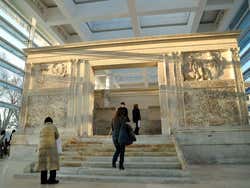
Ara Pacis
The Ara Pacis is a commemorative monument that was built between the years 13 and 9 B.C. to celebrate peace in the Mediterranean after the victorious battles of Emperor Augustus in Hispania and Gaul.
The Ara Pacis is an altar located in the interior of a closed structure carved in Carrara marble. It stands out because of its impressive decoration made up of various reliefs showing the family of Augustus in procession, in addition to different allegories related to the mythical foundation of Rome.
Ara Pacis in the past
Erected in the Campus Martius, the monument was dedicated to the Roman goddess of Peace. Each year, a ram and two oxen were sacrificed in the goddess's honor.
The altar was located in such a way that the shadow of the great obelisk located in the Campus Martius was projected on the Ara Pacis on the birthday of Augustus.
Due to the expansion of the river, the altar was submerged in mud, where it remained for more than one millennium. It was not until the 16th century that some of the remains were found and in 1938 its reconstruction was carried out, preserving it until the present day.
Ara Pacis today
Although the Ara Pacis is one of the most significant monuments of Ancient Rome, it's the only thing that is exhibited in the interior of the museum, making an entrance ticket quite expensive. It's best to look at the altar from the outside, as the building that contains it is made of glass.


Schedule
Daily: 9:30 am - 7:30 pm
24 and 31st December: 9:30 - 2 pm
1st January: 11 am - 8 pm
Closed: 1st May and 25th December
Price
Adults: € 13 (US$ 15.26)
EU citizens aged 6-25, over 65s: € 8.50 (US$ 9.98)
Transport
Buses: 70, 81, 117, 119, 186 and 628
Nearby places
Piazza del Popolo (499 m) Piazza di Spagna & the Spanish Steps (563 m) Keats-Shelley House (583 m) Santa Maria del Popolo (590 m) National Roman Museum (599 m)

